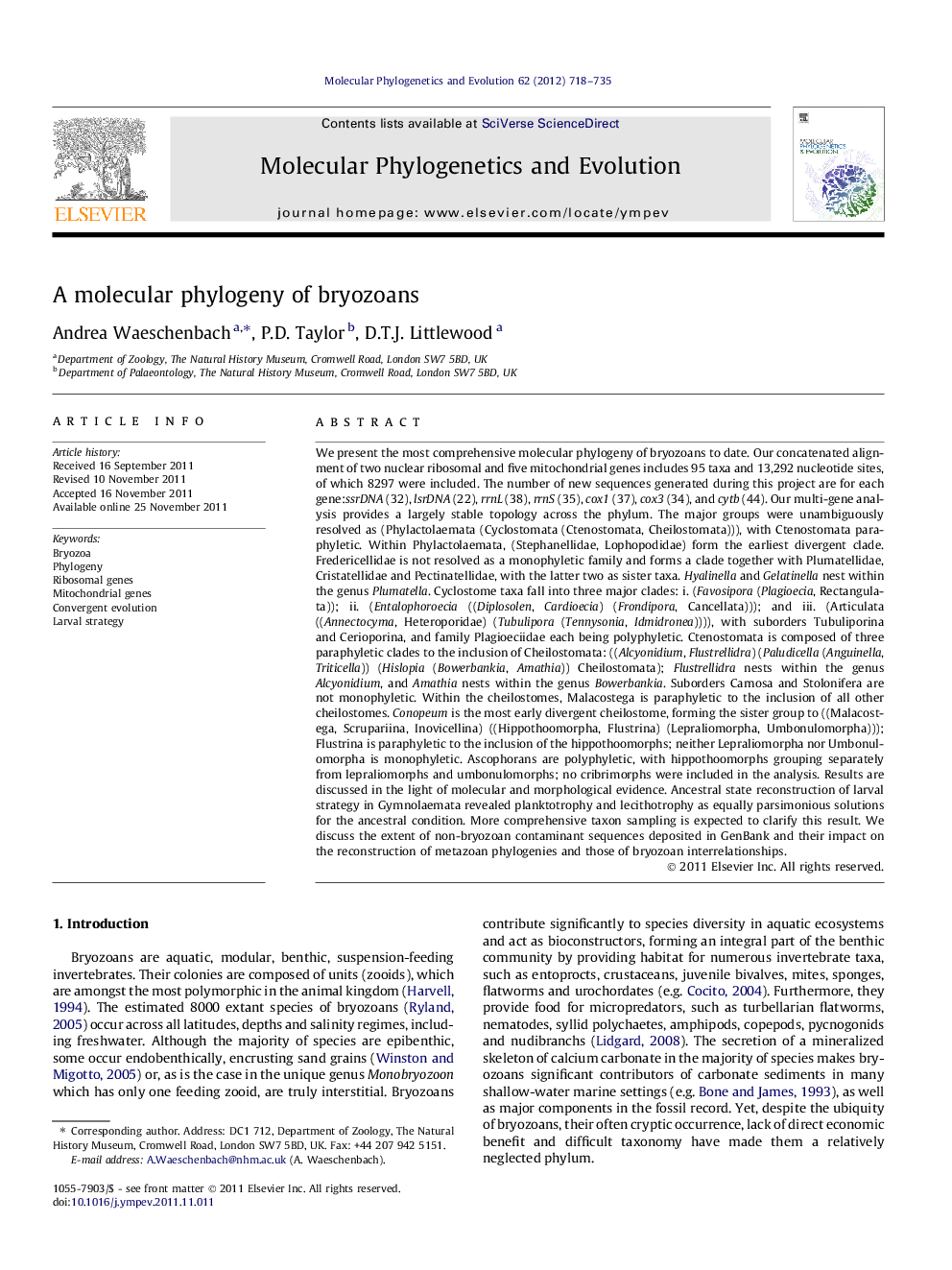| کد مقاله | کد نشریه | سال انتشار | مقاله انگلیسی | نسخه تمام متن |
|---|---|---|---|---|
| 5920507 | 1164291 | 2012 | 18 صفحه PDF | دانلود رایگان |

We present the most comprehensive molecular phylogeny of bryozoans to date. Our concatenated alignment of two nuclear ribosomal and five mitochondrial genes includes 95 taxa and 13,292 nucleotide sites, of which 8297 were included. The number of new sequences generated during this project are for each gene:ssrDNA (32), lsrDNA (22), rrnL (38), rrnS (35), cox1 (37), cox3 (34), and cytb (44). Our multi-gene analysis provides a largely stable topology across the phylum. The major groups were unambiguously resolved as (Phylactolaemata (Cyclostomata (Ctenostomata, Cheilostomata))), with Ctenostomata paraphyletic. Within Phylactolaemata, (Stephanellidae, Lophopodidae) form the earliest divergent clade. Fredericellidae is not resolved as a monophyletic family and forms a clade together with Plumatellidae, Cristatellidae and Pectinatellidae, with the latter two as sister taxa. Hyalinella and Gelatinella nest within the genus Plumatella. Cyclostome taxa fall into three major clades: i. (Favosipora (Plagioecia, Rectangulata)); ii. (Entalophoroecia ((Diplosolen, Cardioecia) (Frondipora, Cancellata))); and iii. (Articulata ((Annectocyma, Heteroporidae) (Tubulipora (Tennysonia, Idmidronea)))), with suborders Tubuliporina and Cerioporina, and family Plagioeciidae each being polyphyletic. Ctenostomata is composed of three paraphyletic clades to the inclusion of Cheilostomata: ((Alcyonidium, Flustrellidra) (Paludicella (Anguinella, Triticella)) (Hislopia (Bowerbankia, Amathia)) Cheilostomata); Flustrellidra nests within the genus Alcyonidium, and Amathia nests within the genus Bowerbankia. Suborders Carnosa and Stolonifera are not monophyletic. Within the cheilostomes, Malacostega is paraphyletic to the inclusion of all other cheilostomes. Conopeum is the most early divergent cheilostome, forming the sister group to ((Malacostega, Scrupariina, Inovicellina) ((Hippothoomorpha, Flustrina) (Lepraliomorpha, Umbonulomorpha))); Flustrina is paraphyletic to the inclusion of the hippothoomorphs; neither Lepraliomorpha nor Umbonulomorpha is monophyletic. Ascophorans are polyphyletic, with hippothoomorphs grouping separately from lepraliomorphs and umbonulomorphs; no cribrimorphs were included in the analysis. Results are discussed in the light of molecular and morphological evidence. Ancestral state reconstruction of larval strategy in Gymnolaemata revealed planktotrophy and lecithotrophy as equally parsimonious solutions for the ancestral condition. More comprehensive taxon sampling is expected to clarify this result. We discuss the extent of non-bryozoan contaminant sequences deposited in GenBank and their impact on the reconstruction of metazoan phylogenies and those of bryozoan interrelationships.
Highlights⺠Bryozoa major clades: (Phylactolaemata (Cyclostomata (Ctenostomata, Cheilostomata))). ⺠Ctenostomata are paraphyletic to the inclusion of Cheilostomata. ⺠Ascus has evolved multiple times. ⺠Skeletal characters are homoplasious and bryozoan taxonomy needs major revision. ⺠Multiple shifts between planktotrophic and lecithotrophic larval strategies.
Journal: Molecular Phylogenetics and Evolution - Volume 62, Issue 2, February 2012, Pages 718-735